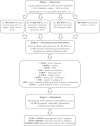Exome sequencing-driven discovery of coding polymorphisms associated with common metabolic phenotypes
- PMID: 23160641
- PMCID: PMC3536959
- DOI: 10.1007/s00125-012-2756-1
Exome sequencing-driven discovery of coding polymorphisms associated with common metabolic phenotypes
Abstract
Aims/hypothesis: Human complex metabolic traits are in part regulated by genetic determinants. Here we applied exome sequencing to identify novel associations of coding polymorphisms at minor allele frequencies (MAFs) >1% with common metabolic phenotypes.
Methods: The study comprised three stages. We performed medium-depth (8×) whole exome sequencing in 1,000 cases with type 2 diabetes, BMI >27.5 kg/m(2) and hypertension and in 1,000 controls (stage 1). We selected 16,192 polymorphisms nominally associated (p < 0.05) with case-control status, from four selected annotation categories or from loci reported to associate with metabolic traits. These variants were genotyped in 15,989 Danes to search for association with 12 metabolic phenotypes (stage 2). In stage 3, polymorphisms showing potential associations were genotyped in a further 63,896 Europeans.
Results: Exome sequencing identified 70,182 polymorphisms with MAF >1%. In stage 2 we identified 51 potential associations with one or more of eight metabolic phenotypes covered by 45 unique polymorphisms. In meta-analyses of stage 2 and stage 3 results, we demonstrated robust associations for coding polymorphisms in CD300LG (fasting HDL-cholesterol: MAF 3.5%, p = 8.5 × 10(-14)), COBLL1 (type 2 diabetes: MAF 12.5%, OR 0.88, p = 1.2 × 10(-11)) and MACF1 (type 2 diabetes: MAF 23.4%, OR 1.10, p = 8.2 × 10(-10)).
Conclusions/interpretation: We applied exome sequencing as a basis for finding genetic determinants of metabolic traits and show the existence of low-frequency and common coding polymorphisms with impact on common metabolic traits. Based on our study, coding polymorphisms with MAF above 1% do not seem to have particularly high effect sizes on the measured metabolic traits.
Figures


References
Publication types
MeSH terms
Grants and funding
LinkOut - more resources
Full Text Sources
Other Literature Sources
Miscellaneous

